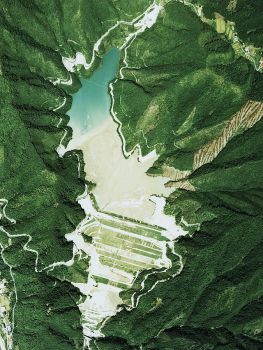O&M of Tailings Dams

|
| Wasabo Tailings Dam, Japan.
(Image Source: Copyright © National Land Image Information) |
The operation and maintenance of tailings dams are to their long-term stability and to minimize the potential environmental risks associated with mining waste. Tailings dams require ongoing monitoring, management, and maintenance to prevent failures and other potential issues.
Effective monitoring and surveillance systems are vital for the safe operation of tailings dams. These systems consist of various sensors, instrumentation, and data collection methods to monitor key parameters such as water levels, dam movements, seepage rates, and structural integrity. Regular inspections and data analysis help identify any potential issues, allowing for preventive actions before said issues become crises. With time, more advanced technologies, including remote sensing and real-time monitoring, are being developed and utilized in dam surveillance.
Water management, including efficient control of inflows and outflows and monitoring water quality, also play a critical role in the operation of tailings dams as they are designed to retain water within the storage area while minimizing seepage. The implementation of highly regulated liner systems, including clay or synthetic materials, helps reduce seepage rates and protect groundwater resources.
As tailings dams are often considered high hazard, they must have robust emergency preparedness and response plans in place to address potential incidents or failures. These plans include clear communication channels, evacuation procedures, and emergency action plans to contain any releases or breaches. Response teams must be prepared to respond in a coordinated manner to crises.
Tailings dams often exist in sensitive ecosystems, so their operation should include measures to minimize their environmental impact. This includes the implementation of erosion control measures, sedimentation ponds, and re-vegetation programs to restore impacted areas. Regular monitoring of water quality downstream from the dam ensures the protection of aquatic habitats and prevents pollution.
Aging infrastructure and changing site conditions may require retrofitting or upgrading measures to ensure continued safety of a tailings dam. Ultimately, when it reaches the end of its useful life, a decommissioning plan is executed, which includes activities such as tailings removal and site rehabilitation.
Best Practices Resources
![]() Tailings Management: Good Practice Guide, ICMM
Tailings Management: Good Practice Guide, ICMM
![]() Global Industry Standard on Tailings Management, ICMM
Global Industry Standard on Tailings Management, ICMM
![]() Safety Guidelines and Good Practices for Tailings Management Facilities (ECE 1326665), UN
Safety Guidelines and Good Practices for Tailings Management Facilities (ECE 1326665), UN
